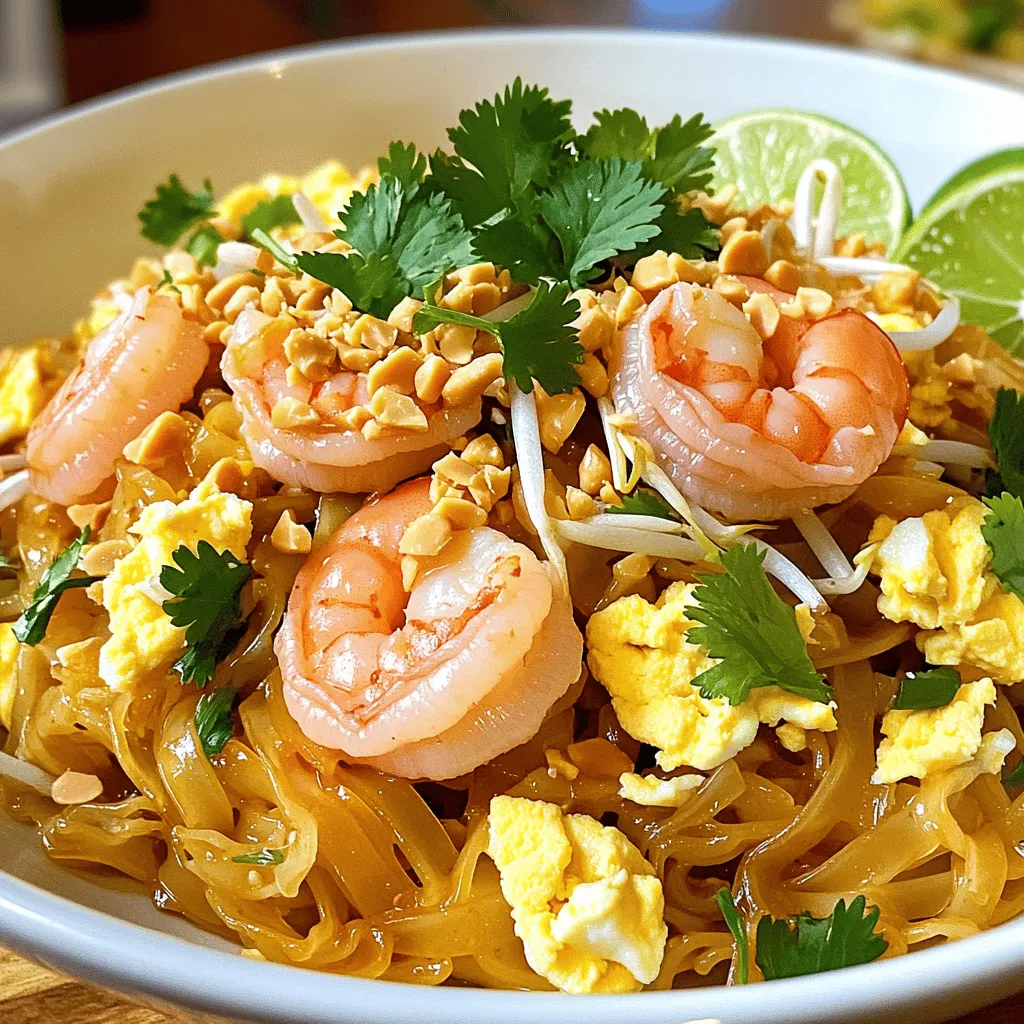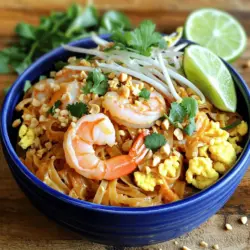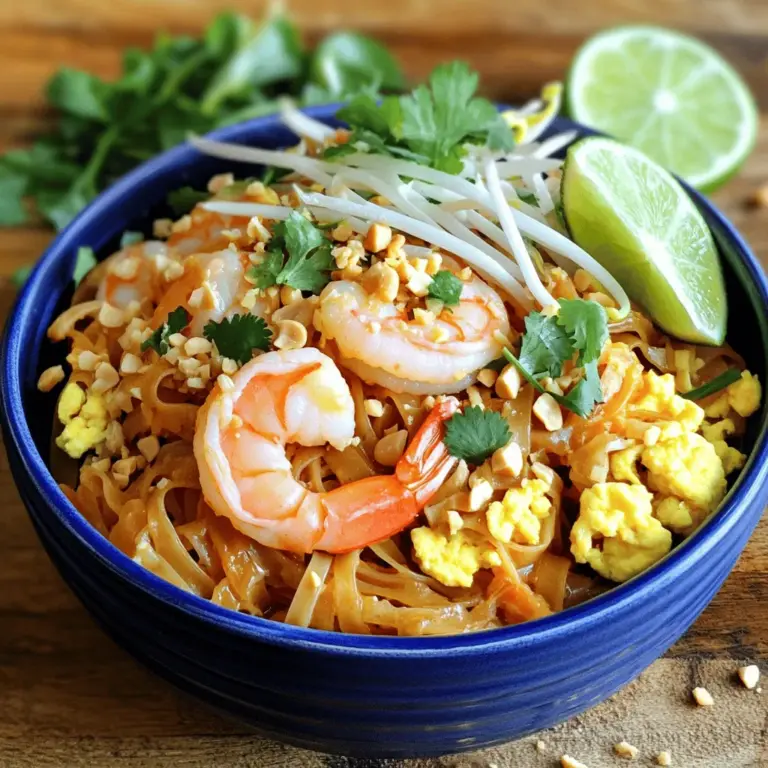If you’re craving a quick, tasty meal, my Easy Pad Thai with Shrimp recipe is perfect for you! This dish is packed with flavor and takes only minutes to prepare. In this post, I’ll share the simple ingredients, step-by-step instructions, and helpful tips to make your Pad Thai shine. Whether you’re a seasoned cook or a beginner, you’ll love how easy it is to whip up this classic dish right at home!
Ingredients
Detailed List of Ingredients
To make your Easy Pad Thai with Shrimp, gather these tasty ingredients:
– 200g rice noodles
– 200g shrimp, peeled and deveined
– 2 tablespoons vegetable oil
– 2 cloves garlic, minced
– 2 eggs, lightly beaten
– 2 tablespoons fish sauce
– 1 tablespoon tamarind paste
– 1 tablespoon brown sugar
– 1 cup bean sprouts
– 2 green onions, sliced
– 1/4 cup crushed peanuts
– Lime wedges for serving
– Fresh cilantro for garnish
– Salt and pepper to taste
Ingredient Substitutions
If you can’t find something or wish to swap, here are some easy swaps:
– Rice noodles: Use any flat noodles or even spaghetti.
– Shrimp: Substitute with chicken or tofu for a different taste.
– Fish sauce: Soy sauce works well for a vegetarian option.
– Tamarind paste: Use lime juice for a bit of tang.
– Bean sprouts: Try shredded carrots or cabbage instead.
Tips for Fresh Ingredients
Using fresh ingredients makes your Pad Thai taste better. Here are some tips:
– Buy shrimp that smell fresh and have a firm texture.
– Choose rice noodles that are soft and not broken.
– Look for vibrant green onions with no wilting.
– Always select cilantro that is bright green and fragrant.
– Store your ingredients in a cool place to keep them fresh longer.
Step-by-Step Instructions
Preparation Steps
To make Easy Pad Thai with shrimp, you need to prep your ingredients first. Start by soaking the rice noodles in warm water for about 30 minutes. This softens the noodles and helps them cook faster. While they soak, peel and devein the shrimp if you haven’t done so yet. Mince the garlic and slice the green onions. You want everything ready to go for quick cooking.
Cooking Techniques
Heat the vegetable oil in a large skillet or wok over medium heat. Once the oil is hot, add the minced garlic. Stir it for about 30 seconds until it smells great. Next, add the shrimp to the pan. Cook them until they turn pink, which takes about 3-4 minutes. Push the shrimp to one side of the skillet. Pour the beaten eggs into the clear space. Scramble the eggs until they are fully cooked, then mix them with the shrimp.
After that, add the soaked rice noodles, fish sauce, tamarind paste, and brown sugar. Toss everything well so the noodles soak up the flavors. Finally, fold in the bean sprouts and green onions. Cook for another minute to warm them through.
Visual Cues for Doneness
You’ll know your shrimp are done when they turn a bright pink color. The eggs should look firm and set, not runny. The noodles should be soft and flexible but not mushy. The bean sprouts should still have a little crunch. When everything looks good, it’s time to plate your dish. Serve it hot, topped with crushed peanuts, cilantro, and lime wedges for that extra zing.
Tips & Tricks
Common Mistakes to Avoid
When making Pad Thai, avoid overcooking the noodles. They should be soft but firm. If they get too mushy, your dish will lose texture. Also, don’t skip the fish sauce; it adds the umami flavor that makes this dish shine. Another mistake is not prepping your ingredients first. This dish cooks quickly, so having everything ready is key.
How to Make It Spicier
Want more heat? Add sliced fresh chili peppers or a dash of chili paste. You can mix the chili paste into the sauce for a more even flavor. If you like it fiery, use Thai bird chilies. Start with a small amount and add more to suit your taste.
Serving Suggestions for Pad Thai
Serve your Pad Thai hot and garnished with lime wedges and fresh cilantro. The lime adds a nice zing that brightens the dish. You can also sprinkle more crushed peanuts on top for extra crunch. Pair it with a light salad or spring rolls for a full meal.

Variations
Vegetarian Pad Thai Options
You can easily make Pad Thai vegetarian. Swap shrimp for firm tofu. Tofu absorbs flavors well. It gives a nice texture. Use the same cooking steps. You can also add more veggies. Try bell peppers, carrots, or broccoli. These add color and crunch. For extra flavor, use soy sauce instead of fish sauce. You can also use a vegan fish sauce if you like. This way, you keep the taste but stay plant-based.
Alternative Proteins (Tofu, Chicken)
If you want to change the protein, chicken works great too. Use boneless, skinless thighs or breasts. Cut them into bite-sized pieces. Cook them the same way as shrimp. They need about 5-7 minutes to cook fully. Tofu is another good option. Just remember to press it first. This helps remove excess moisture. This way, the tofu gets crispy. It adds a nice flavor to the dish.
Gluten-Free Modifications
For those who need gluten-free options, rice noodles are perfect. They are naturally gluten-free. Just check the label to be sure. Instead of soy sauce, use tamari. Tamari has a similar taste and is gluten-free. Also, check the fish sauce brand. Most fish sauces are gluten-free, but it’s good to verify. These simple swaps let everyone enjoy this tasty dish without worry.
Storage Info
How to Store Leftovers
After you enjoy your Easy Pad Thai with Shrimp, store any leftovers in an airtight container. Let the dish cool to room temperature first. This helps keep it fresh. You can keep it in the fridge for up to three days. If you want to enjoy it later, consider freezing it.
Reheating Guidelines
To reheat, use a skillet over medium heat. Add a splash of water or oil to prevent sticking. Heat until warm, stirring often. This helps the flavors mix again. You can also use a microwave. Place the Pad Thai in a microwave-safe dish. Cover it loosely and heat in short bursts, stirring in between.
Freezing Pad Thai
If you want to freeze Pad Thai, it’s simple! Place your cooled leftovers in a freezer-safe bag or container. Remove as much air as possible to prevent freezer burn. It can last up to three months in the freezer. When you’re ready to eat, thaw it in the fridge overnight. Then, reheat as mentioned above for the best taste.
FAQs
What is the best type of noodles for Pad Thai?
The best noodles for Pad Thai are rice noodles. They cook quickly and absorb flavors well. Look for flat rice noodles, often labeled as “Pad Thai noodles.” You can find them in most grocery stores. Make sure to soak them in warm water before cooking. This helps them get soft and ready for your dish.
Can I use pre-cooked shrimp for this recipe?
Yes, you can use pre-cooked shrimp. They save time and make the meal quicker. Just warm them in the skillet until hot. Be careful not to overcook, as they can become rubbery. Toss them in with the garlic first, so they absorb some flavor.
How long does homemade Pad Thai last in the fridge?
Homemade Pad Thai lasts about 2-3 days in the fridge. Store it in an airtight container to keep it fresh. When you are ready to eat, just reheat it in a pan or microwave. Add a splash of water if it seems dry. This will help bring back the original flavors.
In this post, we explored Pad Thai, from key ingredients to cooking tips. You learned about ingredient swaps and how to choose fresh items. We covered step-by-step instructions and shared tips to avoid common mistakes. We also looked at vegetarian options and how to store leftovers.
Remember, great Pad Thai starts with good ingredients and careful cooking. Use this guide to make a tasty dish you’ll love!


